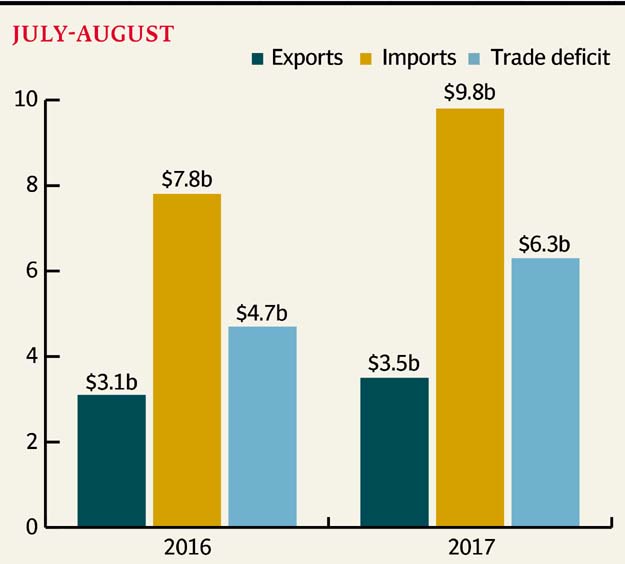
The July-August trade deficit of $6.3 billion was 33.5% higher than the deficit recorded in the same period of previous fiscal year. Pakistan also registered its highest single-month import bill at $5.5 billion in August, which indicated another difficult year for the country.
Curbing Trade Deficit: Industrialists demand policy steps
The value of imported goods exceeded the value of export goods by $6.29 billion in July-August FY18 over a year ago, reported the Pakistan Bureau of Statistics (PBS) on Monday.
The trade deficit was $1.6 billion more than the same period of previous year.
The trade deficit surged despite a higher base as Pakistan had closed the last fiscal year at a record $32.5-billion trade gap. Owing to this, the current account deficit also peaked at $12.1 billion last year, resulting in a reduction of $2 billion in the central bank’s foreign currency reserves.

Exports in July-August FY18 increased 11.8% to $3.5 billion. In absolute terms, the export receipts were $369 million higher than the same period of previous year.
The value of imports stood at $9.8 billion, which was 24.85% or $1.95 billion higher than the import bill in the corresponding period of previous fiscal year.
For the new fiscal year 2017-18, the federal government has targeted to increase exports to $23.1 billion, which requires 13.2% growth over last year’s exports of $20.5 billion.
On the other hand, the government aims to curtail the import bill to $48.8 billion, which seems impossible, given the trend witnessed in the first two months.
This will have direct implications for the current account deficit that is projected at $8.9 billion in FY18. Independent economists, however, have estimated the current account deficit in the range of $13 billion to $14 billion.
A higher-than-projected current account deficit will have direct bearing on the foreign currency reserves, which are again on the decline, standing at only $14.6 billion at the end of August 2017.Pakistan will require about $20 billion in the current fiscal year to meet its external financing requirements including debt repayment obligations.
However, the good thing for now is that exports are growing in double digits for two consecutive months and if the trend persists, the government may achieve its annual target.
However, the problem is growing imports as budgetary measures taken to curb imports have proved inadequate.
Annualised data
The PBS data showed that Pakistan’s exports grew 25.17% to $2.1 billion in August over the same month of previous year. In absolute terms, the export receipts rose $416 million.
Trade deficit of South Asia: is it all bad for the economy?
However, imports grew at a faster pace of 27.63% and the country borne the highest monthly import bill of $5.49 billion in August. The import bill was $1.2 billion more than that in August 2016.
Consequently, the trade deficit widened 29.1% or $3.4 billion in August over the same month of previous year. In absolute terms, the deficit was higher by $1.8 billion.
Monthly results
On a month-on-month basis, exports in August increased 26.9% to $2.1 billion over July. These were $438 million higher than the receipts in the preceding month.
Imports grew 13.6% over July to $5.49 billion. The month-on-month trade deficit was 6.8% higher in August over July.
Published in The Express Tribune, September 12th, 2017.
Like Business on Facebook, follow @TribuneBiz on Twitter to stay informed and join in the conversation.
































1714024018-0/ModiLara-(1)1714024018-0-270x192.webp)










COMMENTS
Comments are moderated and generally will be posted if they are on-topic and not abusive.
For more information, please see our Comments FAQ